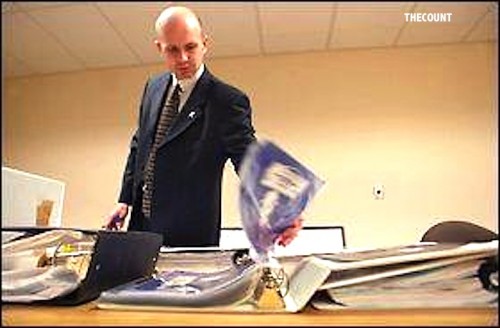I did a little digging and I discovered, Fred Humphries, the FBI agent who sent the shirtless photos, you know the guy involved in the Gen. Petraeus case, has actually been involved in fighting terrorism since at least 1999.
I found this interesting story from the Seattle Times that describes an anti-terrorism mission that Humphries was actively involved in back in 2000.
|
Advertisement |
John O’Neill, head of the FBI’s National Security Division in New York, had been the FBI’s most single-minded pursuer of Osama bin Laden and al-Qaida. O’Neill figured the young agent leading the Ressam case out of Seattle could use all the help he could get.
When he called Fred Humphries in early January, the agent listened intently. There’s someone you have to meet, O’Neill said. He may have a lot of answers for you.
The man was O’Neill’s friend and fellow cigar aficionado, Jean-Louis Bruguière, one of the world’s premier terrorist-trackers. Bruguière had called O’Neill from Paris after learning of Ressam’s arrest to say he had important intelligence about the captive’s activities and connections in Montreal.
Within a week, Humphries traveled to New York and met Bruguière. Humphries was taken aback at first, finding the flamboyant Frenchman imperious. For his part, Bruguière wondered why the FBI had assigned this important case to a rookie.
But Bruguière trusted O’Neill and extended that trust to Humphries. He began educating the American about Islamic cells in general and the Montreal cell in particular, sharing hundreds of documents. Almost immediately, Humphries was stunned by something Bruguière said: The Frenchman had warned Canadian authorities about the Montreal cell four years earlier, and the Canadians had been watching Ressam and his associates ever since.
As Bruguière and Humphries talked, this odd couple of counterterrorism — the fashionable French magistrate and the prematurely bald, ex-paratrooper from Steilacoom, Wash. — grew more comfortable. That evening, O’Neill took them out on the town, requisitioning a SWAT team for security and roaring off in a black SUV, lights flashing and sirens echoing along Manhattan’s skyscraper canyons.
At Cité, a fashionable steakhouse, the SWAT team checked for danger, then set up a guard post outside while the trio dined in style.
Within weeks, Humphries and the U.S. attorney from Seattle, Kate Pflaumer, traveled to Paris for “Terrorism 101,” a crash course in Bruguière’s nearly two decades of experience. He unraveled the twisted route of a Montreal jihad cell, whose beginnings in Algeria had wound through the battlefields of Bosnia, a burned-out, bullet-ridden house in the French city of Roubaix and a musty flat in Montreal.
Over the next several months, Humphries and his colleagues worked to build a solid case against Ressam, while his public defenders, just as diligently, met with their client at the Federal Detention Center in SeaTac to assemble a defense.
Humphries traveled nearly 300,000 miles, to France, Algeria, Germany and England, trying to establish Ressam’s links to Islamic terrorists. He talked constantly with Bruguière, getting advice, sharing information when he could.
They suspected, but couldn’t prove, that Ressam had been trained by bin Laden. They had no idea of his intended target.
In May 2000, Humphries and federal prosecutors visited the Montreal headquarters of the Canadian Security Intelligence Service. They learned for the first time that CSIS had intercepted more than 400 hours of conversations among Ressam and his “bunch of guys.” They were disappointed to learn that CSIS routinely erased such tapes, though, and that only typed summaries of the talks remained.
Humphries studied the other evidence the Canadians had seized in the Montreal apartment: Wool slacks and black-suede Vittorio Virgili shoes with burn holes, likely caused by drops of acid used in brewing explosives. An illegal 9 mm handgun, wrapped in a Hugo Boss shirt and hidden in a stove. A map of greater Los Angeles.
The holes in the slacks, Humphries determined, matched deep burns on Ressam’s leg, a key piece of evidence. The agent also noticed something the Canadian police had missed: He unfolded the L.A. map and discovered that someone, presumably Ressam, had drawn circles around the area’s three airports.
This, combined with other evidence, led Humphries to conclude this: Seattle was not Ressam’s destination of destruction but simply a way station on his way to Southern California. And an airport — perhaps Los Angeles International, one of the nation’s busiest — was the likely target.
About that shirtless photo: Yes, he sent such a photo to Kelley years ago, but it was harmless fun, says his lawyer. “It was sent as part of a larger context of what I would call social relations in which the families would exchange numerous photos of each other.”





